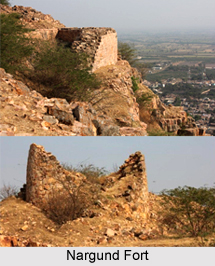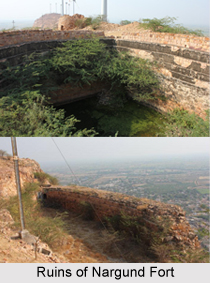 Nargund Fort is situated in the town of Nargund (Naragunda) in the district of Gadag, Karnataka. The average altitude of the town is 605 m. The fort is ideally located on a hilltop and forms a perfect backdrop for a town which is otherwise not on the major tourist circuit of Karnataka. The fort has a rich history and heritage associated with it. The fort has remained witness to many armed rebellions.
Nargund Fort is situated in the town of Nargund (Naragunda) in the district of Gadag, Karnataka. The average altitude of the town is 605 m. The fort is ideally located on a hilltop and forms a perfect backdrop for a town which is otherwise not on the major tourist circuit of Karnataka. The fort has a rich history and heritage associated with it. The fort has remained witness to many armed rebellions.
History of Nargund Fort
Historically, Nargund Fort is of much significance. This was one of the many forts which Chhatrapati Shivaji Maharaj constructed. The fort was under the control of the Maratha forces for the first 15 years after it was constructed. However, in the year 1961, the then Mughal Emperor Aurangzeb attacked the fort and occupied it by defeating the Maratha soldiers. It was only under the rule of Ramrao Dadaji Bhave that the Marathas were able to wrest the control of the fort from the Mughal in 1707.
In the 18th century, the fortress and the territory were controlled by the ruler Venkat Rao of the Bhave dynasty under the Maratha Peshwas of Pune. In the year 1778, the fort of Nargund was captured by Sultan Hyder Ali who was the ruler of the Kingdom of Mysore. Later in 1784, Tipu Sultan of Mysore seized the possession of the fort.
The Nargund Fort was also part of the uprising against the British during the Sepoy Mutiny in the year 1857. Later, the British forces under the command of Colonel Malcolm attacked the fort and captured it.
 Architecture of Nargund Fort
Architecture of Nargund Fort
The Nargund Fort had a remarkable construction. Shivaji planned the fortification of the hill in great detail, so that it would not be easily captured by the enemy forces. The fort was built to extend his empire and establish his hold over the region. As such, much of the area inside the fort was earmarked to be utilized by his forces. Unlike many other forts in India, the Nargund fort had no ornate palaces or dance floors constructed inside the premises. Even gardens were not developed inside the fort. The fort was devoid of any temple complex as well. Shivaji did not consider such things necessary inside a fort and hence, avoided wasting time and resources on their construction.
In spite of the absence of such decorative elements inside the fort, the structure was equipped with all necessary and essential structures and elements like water tanks, ammunition storage rooms, a huge well for water supply inside the fort, watch towers, etc.
Present Condition of Nargund Fort
Today the historic fort stands as a heap of ruins. Nothing remains of the significant structure. The site of the fort is an open area which anyone can visit at any point of time. Though the site is under the possession of the Government of Karnataka, the area remains an abandoned place.
How to Reach Nargund Fort
Nargund is a small town in the state of Karnataka but it is well connected to several other cities and towns in the state and beyond by the road network. Nargund is around 250 km from Bengaluru and can be reached via State Transport Buses. Bus and taxis can also be taken from other cities like Hubli and Belgaum to reach the Nargund Fort. Mallpur Railway Station at a distance of 25 km is the nearest rail link to Nargund. Hubli Airport at a distance of 48 km and Sambre Airport at a distance of 93 km from Nargund are the nearest airports.



















